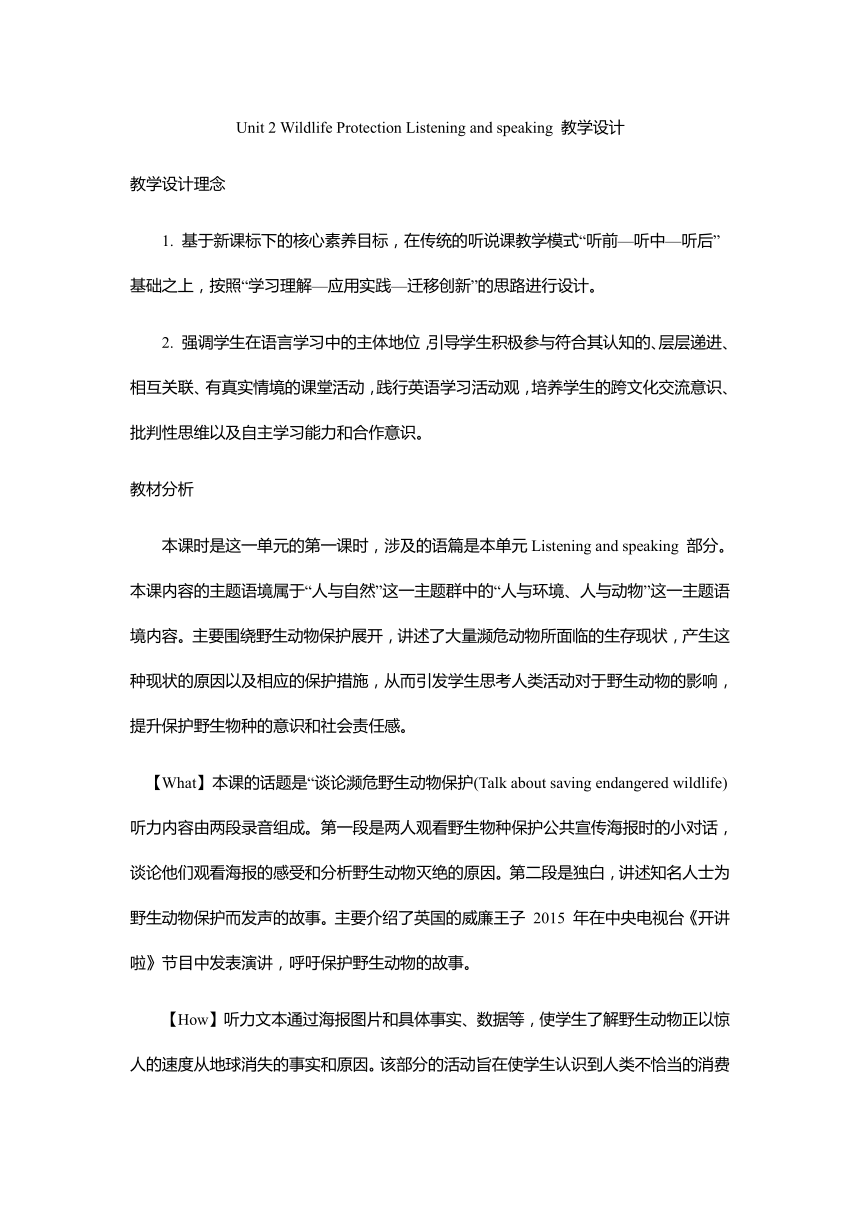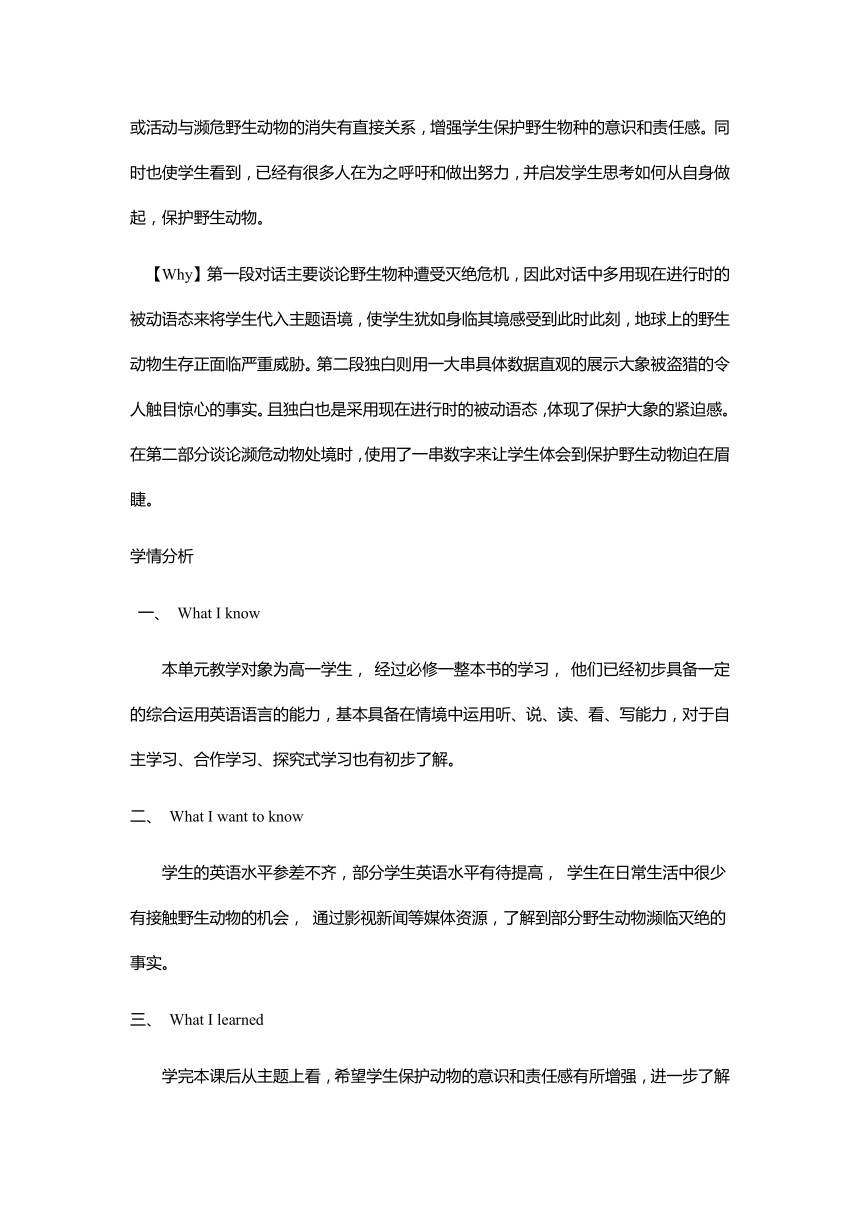Unit 2 Wildlife Protection Listening and Speaking 教学设计-2024-2025学年高中英语人教版(2019)必修第二册
文档属性
| 名称 | Unit 2 Wildlife Protection Listening and Speaking 教学设计-2024-2025学年高中英语人教版(2019)必修第二册 |  | |
| 格式 | docx | ||
| 文件大小 | 25.8KB | ||
| 资源类型 | 教案 | ||
| 版本资源 | 人教版(2019) | ||
| 科目 | 英语 | ||
| 更新时间 | 2025-01-16 23:52:43 | ||
图片预览


文档简介
Unit 2 Wildlife Protection Listening and speaking 教学设计
教学设计理念
1. 基于新课标下的核心素养目标,在传统的听说课教学模式“听前—听中—听后”基础之上,按照“学习理解—应用实践—迁移创新”的思路进行设计。
2. 强调学生在语言学习中的主体地位,引导学生积极参与符合其认知的、层层递进、相互关联、有真实情境的课堂活动,践行英语学习活动观,培养学生的跨文化交流意识、批判性思维以及自主学习能力和合作意识。
教材分析
本课时是这一单元的第一课时,涉及的语篇是本单元Listening and speaking 部分。本课内容的主题语境属于“人与自然”这一主题群中的“人与环境、人与动物”这一主题语境内容。主要围绕野生动物保护展开,讲述了大量濒危动物所面临的生存现状,产生这种现状的原因以及相应的保护措施,从而引发学生思考人类活动对于野生动物的影响,提升保护野生物种的意识和社会责任感。
【What】本课的话题是“谈论濒危野生动物保护(Talk about saving endangered wildlife)听力内容由两段录音组成。第一段是两人观看野生物种保护公共宣传海报时的小对话,谈论他们观看海报的感受和分析野生动物灭绝的原因。第二段是独白,讲述知名人士为野生动物保护而发声的故事。主要介绍了英国的威廉王子 2015 年在中央电视台《开讲啦》节目中发表演讲,呼吁保护野生动物的故事。
【How】听力文本通过海报图片和具体事实、数据等,使学生了解野生动物正以惊人的速度从地球消失的事实和原因。该部分的活动旨在使学生认识到人类不恰当的消费或活动与濒危野生动物的消失有直接关系,增强学生保护野生物种的意识和责任感。同时也使学生看到,已经有很多人在为之呼吁和做出努力,并启发学生思考如何从自身做起,保护野生动物。
【Why】第一段对话主要谈论野生物种遭受灭绝危机,因此对话中多用现在进行时的被动语态来将学生代入主题语境,使学生犹如身临其境感受到此时此刻,地球上的野生动物生存正面临严重威胁。第二段独白则用一大串具体数据直观的展示大象被盗猎的令人触目惊心的事实。且独白也是采用现在进行时的被动语态,体现了保护大象的紧迫感。在第二部分谈论濒危动物处境时,使用了一串数字来让学生体会到保护野生动物迫在眉睫。
学情分析
一、 What I know
本单元教学对象为高一学生, 经过必修一整本书的学习, 他们已经初步具备一定的综合运用英语语言的能力,基本具备在情境中运用听、说、读、看、写能力,对于自主学习、合作学习、探究式学习也有初步了解。
二、 What I want to know
学生的英语水平参差不齐,部分学生英语水平有待提高, 学生在日常生活中很少有接触野生动物的机会, 通过影视新闻等媒体资源,了解到部分野生动物濒临灭绝的事实。
三、 What I learned
学完本课后从主题上看,希望学生保护动物的意识和责任感有所增强,进一步了解保护动物的措施与方法。从语言知识层面上看,语言词汇量方面积累可能不足,教师需要通过教学丰富学生语言表达,激发学生主动思考和分享的欲望。
教学目标 By the end of this class, you will be able to:
教学重难点
1. The development of students' predicting skill before listening by visuals.
2. The precise comprehension of the listening material.
3. The speaking of the situation of the endangered wild animals and their protection.
教学方法 Teaching approach: Activity-oriented Approach; Inquiry Teaching Method; Discovery Method.
Learning Approach: Problem-based Learning; Self-directed Learning; Teamwork.
辅助教具 PowerPoint; blackboard; handouts
教学过程 活动形式及步骤 活动意图
Step1: Lead-in Watch a short video and answer a question. Q: What is happening to the animals To activate students’ knowledge about wild animals and introduce the topic of endangered wildlife and serve as a warm-up activity.
Step II : Pre-listening Activity 1. Students observe the posters and fill in the blanks. 1. A________ and a tiger are standing on the clock. In the middle, there is a gun At the bottom, many animals are _______ 2. This is a sand clock There are _________wildlife species losing every ______! 3.So many sharks are being ________. Up to ______ million sharks end up in shark fin soup each year. Say____ to Shark fin soup! Look at the picture on the text and predict Q: What are we going to hear based on the picture and title (Tip: Use visuals to predict the content) To provide more information and expressions for students to talk about endangered wild animals in the following lesson, and lay a foundation for the following listening which is based on the second poster. To cultivate students predicting skill of the listening content using visuals before listening.
Step III: While-listening Activity 2 Listen to the first part and fill in the blanks. Our planet’s ___________ is dying out at an alarming rate. Between 150 and 200 species die out every day. Some animals are being ________ and _______. And then there’s _________ and habitat _______. Animals need a place to live in, just like us, and they need clean air and water, too. People need to be more aware. We should make more of these _______. Maybe it will help ________ the endangered wildlife before it’s too late. Activity 3 Listen to the second part and answer the questions. 1. In October 2015, Prince William gave a moving speech on CCTV: In the _____ years since I was born, we’ve lost around _____ percent of Africa’s elephant population. Of those that are left,________ are killed every year. That is ______ elephants killed every single day. 2. What did Prince William say about China A. China has made a lot of progress. B. China can become a global leader in wildlife protection. C. China preserves its natural habitats well. 3. You can be the ______ of wildlife protection in your area. Remember: _______ begins with you To practice students’ listening skill for grasping the main idea of the two speakers’ conversation, and make students aware of the serious situation of the endangered animals. To practice students’ listening skill for grasping detailed information and arouse their awareness to make changes now to protect endangered wild animals.
Step IV: Post-listening Activity 4 Discuss the following questions in groups. 1. What does “Change begins with you” mean 2. Do you agree with this sentence 3. What can we students do to protect wildlife Activity5 Summary Activity 6 Role-play In pairs, discuss the questions, role-play the example, and then talk about one of the animals in the photos below. 1.What do you know about the animals in the photos 2.What is being done to help them Critical Thinking Why is it important to protect wildlife they choose. To lead students to think deeper about how to protect wild animals from themselves and authorities, and call on them to protect the endangered wild animals and their habitats. To ask the students to reflect the content of the lesson. To enhance students cooperation ability with group members, develop their speaking skill to talk about the facts or situations of endangered wild animals and measures taken to protect them and let students present their group role-play together on the stage to speak up for the endangered wild animals To help students get a deeper understanding of the lesson.
Step V: homework Design a poster about wildlife protection according to what you have discussed. To consolidate what has been learnt and Inspire students to explore more about endangered wild animals and enrich their after-class activity.
教学设计理念
1. 基于新课标下的核心素养目标,在传统的听说课教学模式“听前—听中—听后”基础之上,按照“学习理解—应用实践—迁移创新”的思路进行设计。
2. 强调学生在语言学习中的主体地位,引导学生积极参与符合其认知的、层层递进、相互关联、有真实情境的课堂活动,践行英语学习活动观,培养学生的跨文化交流意识、批判性思维以及自主学习能力和合作意识。
教材分析
本课时是这一单元的第一课时,涉及的语篇是本单元Listening and speaking 部分。本课内容的主题语境属于“人与自然”这一主题群中的“人与环境、人与动物”这一主题语境内容。主要围绕野生动物保护展开,讲述了大量濒危动物所面临的生存现状,产生这种现状的原因以及相应的保护措施,从而引发学生思考人类活动对于野生动物的影响,提升保护野生物种的意识和社会责任感。
【What】本课的话题是“谈论濒危野生动物保护(Talk about saving endangered wildlife)听力内容由两段录音组成。第一段是两人观看野生物种保护公共宣传海报时的小对话,谈论他们观看海报的感受和分析野生动物灭绝的原因。第二段是独白,讲述知名人士为野生动物保护而发声的故事。主要介绍了英国的威廉王子 2015 年在中央电视台《开讲啦》节目中发表演讲,呼吁保护野生动物的故事。
【How】听力文本通过海报图片和具体事实、数据等,使学生了解野生动物正以惊人的速度从地球消失的事实和原因。该部分的活动旨在使学生认识到人类不恰当的消费或活动与濒危野生动物的消失有直接关系,增强学生保护野生物种的意识和责任感。同时也使学生看到,已经有很多人在为之呼吁和做出努力,并启发学生思考如何从自身做起,保护野生动物。
【Why】第一段对话主要谈论野生物种遭受灭绝危机,因此对话中多用现在进行时的被动语态来将学生代入主题语境,使学生犹如身临其境感受到此时此刻,地球上的野生动物生存正面临严重威胁。第二段独白则用一大串具体数据直观的展示大象被盗猎的令人触目惊心的事实。且独白也是采用现在进行时的被动语态,体现了保护大象的紧迫感。在第二部分谈论濒危动物处境时,使用了一串数字来让学生体会到保护野生动物迫在眉睫。
学情分析
一、 What I know
本单元教学对象为高一学生, 经过必修一整本书的学习, 他们已经初步具备一定的综合运用英语语言的能力,基本具备在情境中运用听、说、读、看、写能力,对于自主学习、合作学习、探究式学习也有初步了解。
二、 What I want to know
学生的英语水平参差不齐,部分学生英语水平有待提高, 学生在日常生活中很少有接触野生动物的机会, 通过影视新闻等媒体资源,了解到部分野生动物濒临灭绝的事实。
三、 What I learned
学完本课后从主题上看,希望学生保护动物的意识和责任感有所增强,进一步了解保护动物的措施与方法。从语言知识层面上看,语言词汇量方面积累可能不足,教师需要通过教学丰富学生语言表达,激发学生主动思考和分享的欲望。
教学目标 By the end of this class, you will be able to:
教学重难点
1. The development of students' predicting skill before listening by visuals.
2. The precise comprehension of the listening material.
3. The speaking of the situation of the endangered wild animals and their protection.
教学方法 Teaching approach: Activity-oriented Approach; Inquiry Teaching Method; Discovery Method.
Learning Approach: Problem-based Learning; Self-directed Learning; Teamwork.
辅助教具 PowerPoint; blackboard; handouts
教学过程 活动形式及步骤 活动意图
Step1: Lead-in Watch a short video and answer a question. Q: What is happening to the animals To activate students’ knowledge about wild animals and introduce the topic of endangered wildlife and serve as a warm-up activity.
Step II : Pre-listening Activity 1. Students observe the posters and fill in the blanks. 1. A________ and a tiger are standing on the clock. In the middle, there is a gun At the bottom, many animals are _______ 2. This is a sand clock There are _________wildlife species losing every ______! 3.So many sharks are being ________. Up to ______ million sharks end up in shark fin soup each year. Say____ to Shark fin soup! Look at the picture on the text and predict Q: What are we going to hear based on the picture and title (Tip: Use visuals to predict the content) To provide more information and expressions for students to talk about endangered wild animals in the following lesson, and lay a foundation for the following listening which is based on the second poster. To cultivate students predicting skill of the listening content using visuals before listening.
Step III: While-listening Activity 2 Listen to the first part and fill in the blanks. Our planet’s ___________ is dying out at an alarming rate. Between 150 and 200 species die out every day. Some animals are being ________ and _______. And then there’s _________ and habitat _______. Animals need a place to live in, just like us, and they need clean air and water, too. People need to be more aware. We should make more of these _______. Maybe it will help ________ the endangered wildlife before it’s too late. Activity 3 Listen to the second part and answer the questions. 1. In October 2015, Prince William gave a moving speech on CCTV: In the _____ years since I was born, we’ve lost around _____ percent of Africa’s elephant population. Of those that are left,________ are killed every year. That is ______ elephants killed every single day. 2. What did Prince William say about China A. China has made a lot of progress. B. China can become a global leader in wildlife protection. C. China preserves its natural habitats well. 3. You can be the ______ of wildlife protection in your area. Remember: _______ begins with you To practice students’ listening skill for grasping the main idea of the two speakers’ conversation, and make students aware of the serious situation of the endangered animals. To practice students’ listening skill for grasping detailed information and arouse their awareness to make changes now to protect endangered wild animals.
Step IV: Post-listening Activity 4 Discuss the following questions in groups. 1. What does “Change begins with you” mean 2. Do you agree with this sentence 3. What can we students do to protect wildlife Activity5 Summary Activity 6 Role-play In pairs, discuss the questions, role-play the example, and then talk about one of the animals in the photos below. 1.What do you know about the animals in the photos 2.What is being done to help them Critical Thinking Why is it important to protect wildlife they choose. To lead students to think deeper about how to protect wild animals from themselves and authorities, and call on them to protect the endangered wild animals and their habitats. To ask the students to reflect the content of the lesson. To enhance students cooperation ability with group members, develop their speaking skill to talk about the facts or situations of endangered wild animals and measures taken to protect them and let students present their group role-play together on the stage to speak up for the endangered wild animals To help students get a deeper understanding of the lesson.
Step V: homework Design a poster about wildlife protection according to what you have discussed. To consolidate what has been learnt and Inspire students to explore more about endangered wild animals and enrich their after-class activity.
